Tillandsia fuchsii forma gracillis
Click thumbnails for full size, scaled to a new window.
Tillandsia fuchsii forma gracillis
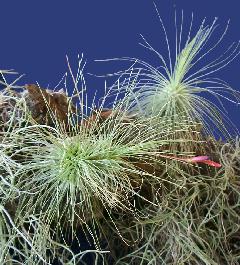
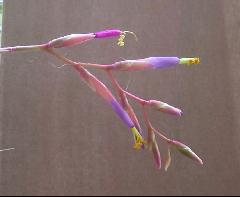
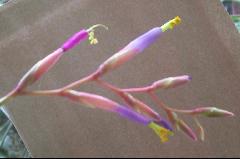
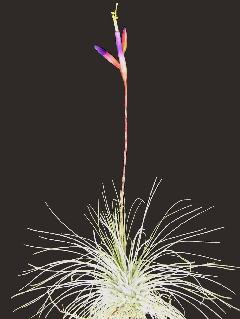
| Ian Hook 05/02 |
Ian Hook 11/03 |
Ken Woods 12/06 |
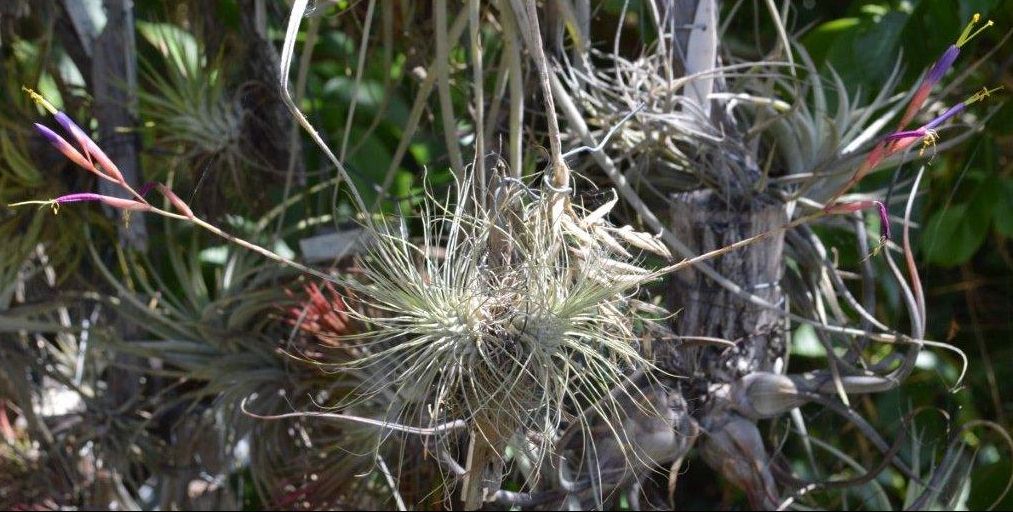
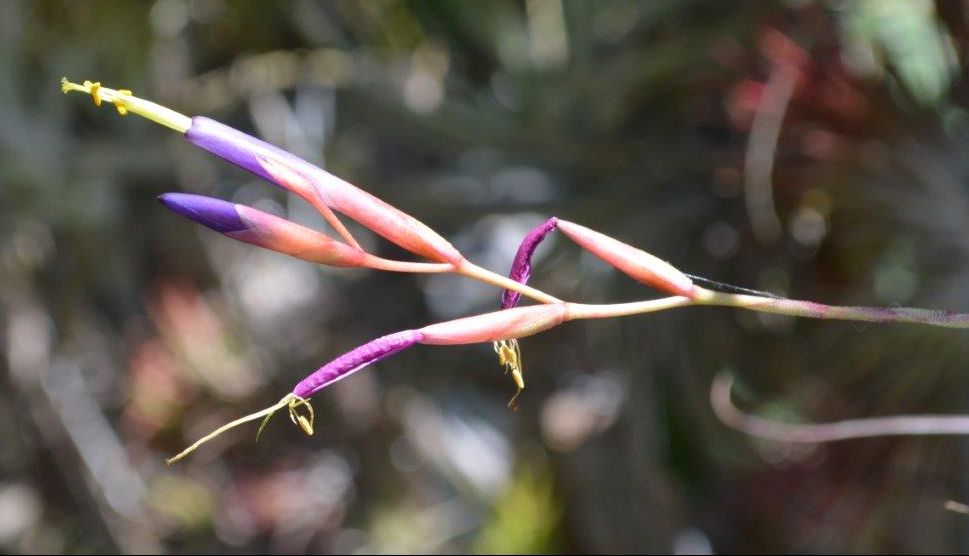
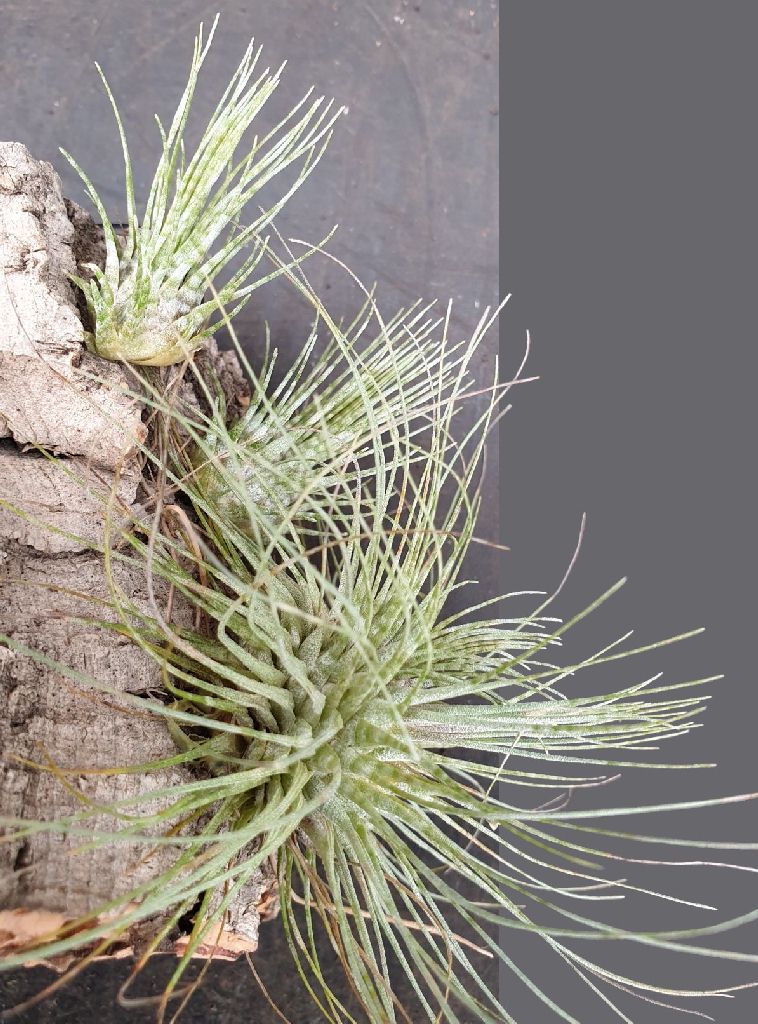
| Rob Bower 11/18 |
Chris Larson 06/19 with banding |
Chris Larson 11/18 ... "The Guatemalan trade uses the name T. argentea for T. fuchsii f. gracilis. T. argentea is rare and difficult to grow except possibly in Cairns. Love to know if it is OK in Brisbane???"
Rob Bower ... "Attached is a pic of my fuchsii f. gracillis from a few months ago. My 'argentea'? has shorter thicker leaves and solid leaf bases -no pic sorry. It very slow growing. They all grow fine on the Sunshine Coast."
Chris Larson ... "T. fuchsii has stouter leaves as well. T. argenteas leaves feel similar to T. atroviridipetala."
Chris Larson 06/19 ... "Zebras. I get a little cynical about the possibilities of these things. It started off ages ago with the single plant. Then it flowered and
. The pups went the same way.
This banded fuchsii v. gracilis was just one that I noticed amongst our stuff we imported. We often see these aberrations & often they dont carry through to the next generation. This shows the next generation ARE consistent, which is a good sign, but I want to see the second to see if it is stable and not cultural."
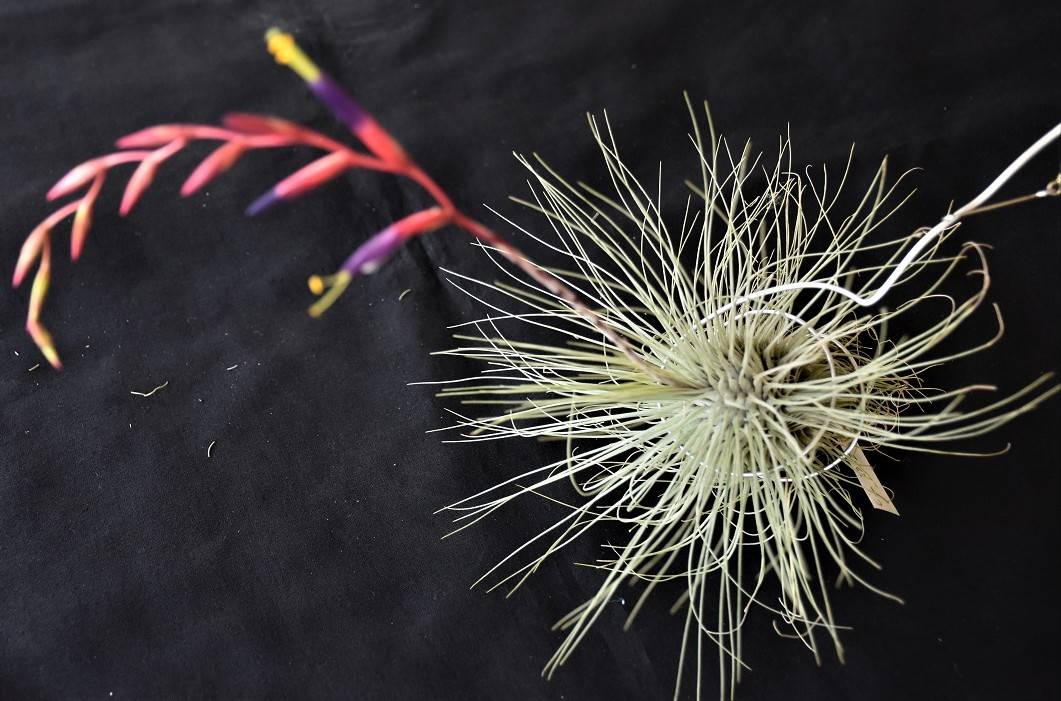
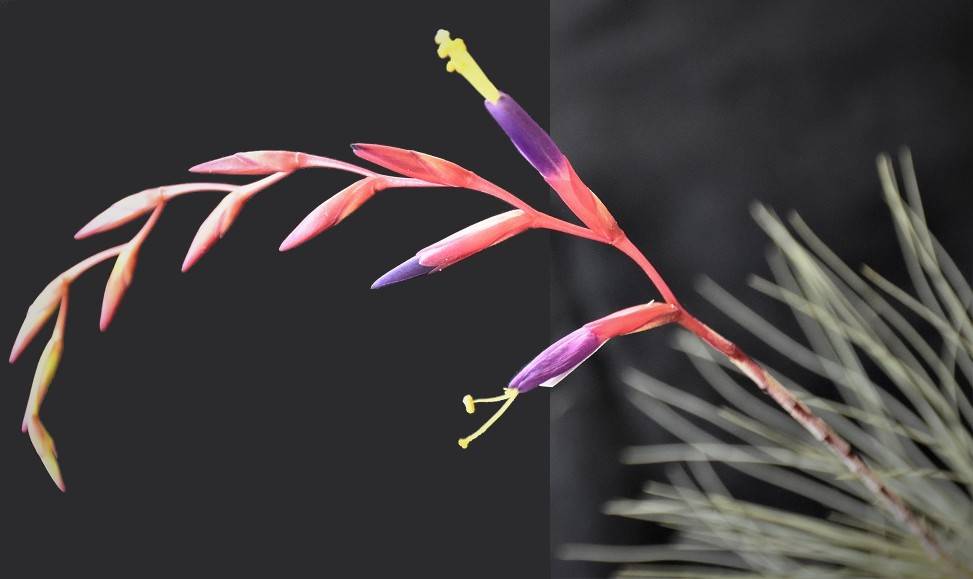
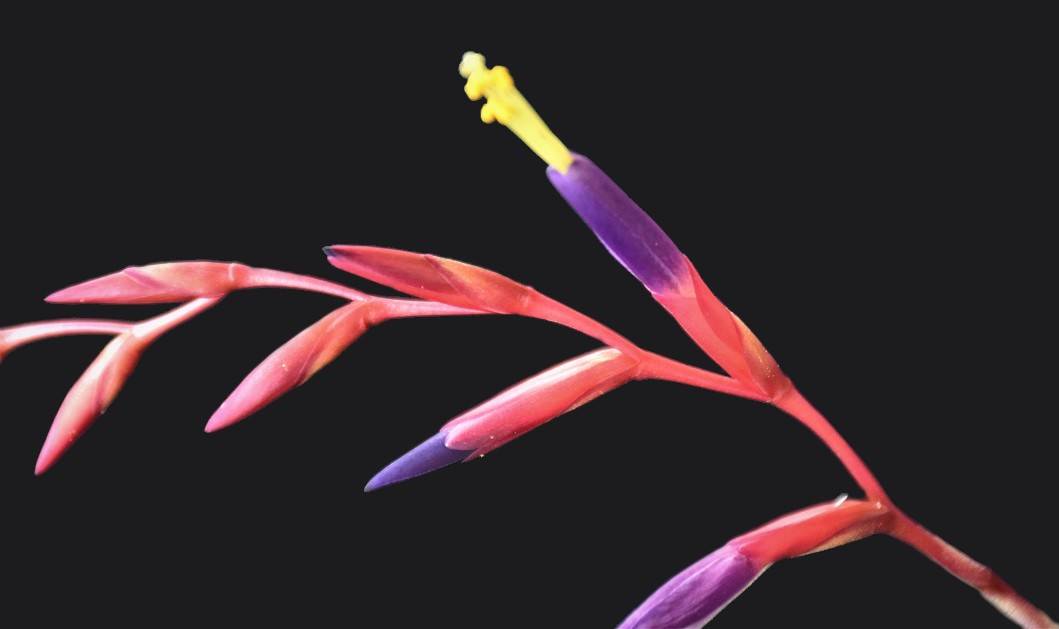 Steve Molnar ... "Another stunner that should be in all collections."
Steve Molnar ... "Another stunner that should be in all collections."
Sue & Steve Davidson ... "I purchased several of these from Bunnings and they are identical to the photo here. I also purchased one of these in SA and it has a green stem instead of the red. Flowers come out the same in both. Do I have two different varieties or just the one."
Chris Larson ... "All species have a natural variation. I would consider the colour of the scape not enough to doubt it is that species, especialy, as you say, everything else is the same. Often these types of things are not important to the taxonomist.
Things like stem colour, or any other substantial variant, are often used to give the plant a cv name. Though I do not know of one in this case. My collection is full of little notes on the labels with things like this written on them in this case it would be T. fuchsii var gracilis w/ green scape.
Any variation should be observed over multiple generations, well at least 2 - to see if it holds, if you intend to register it with the BCR. (Too many see the difference occur in one generation then assume that it will occur again.)
I just have them floating around with these little notes on the tags."
Lloyd Goodman ... "Chris is right on this one I had a conversation with David Benzing on this. When plants are grown from seed each has its own unique DNA. We only see visual differences but there is also different ways each plant can react to heat cold dryness etc. This is why one plant might thrive while another dies."
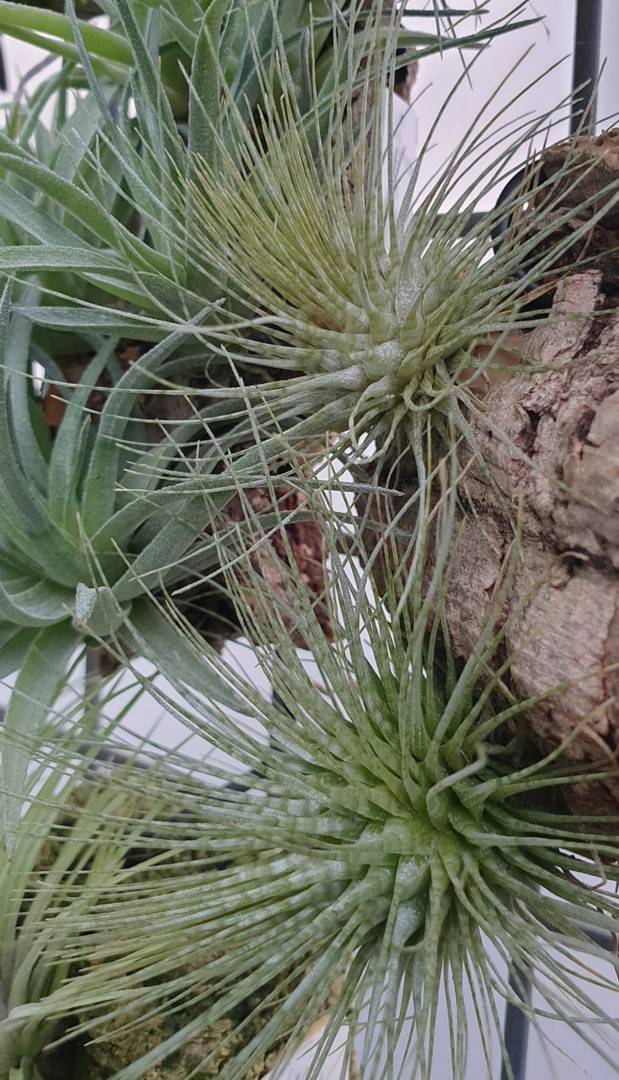
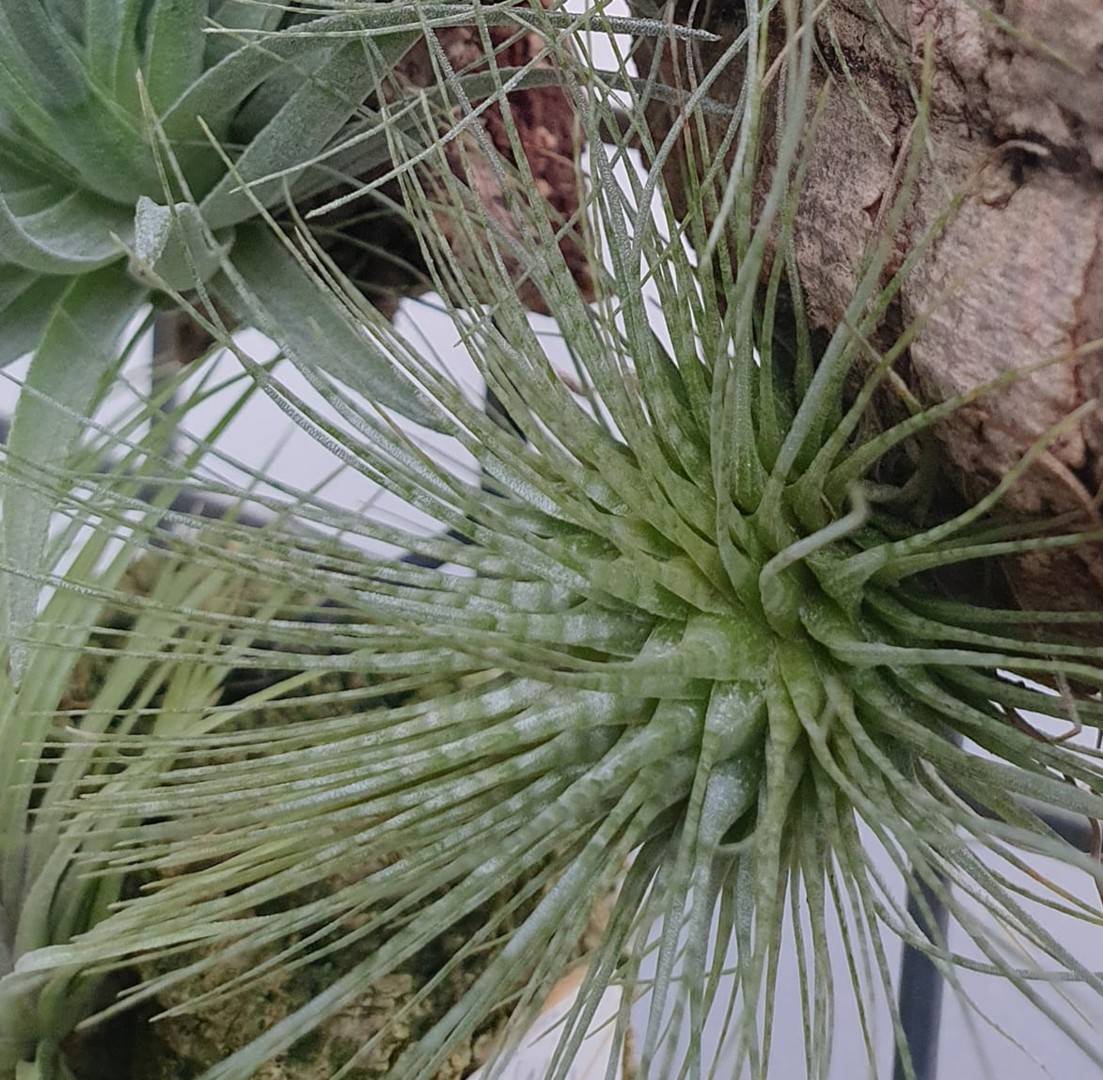


| Chris Larson 04/22 with banding |
Ian Hook 11/24 (vivaporous?) |
Chris Larson ... "T. fuchsii f. gracillis - a special one - and yes it holds the banding."
Ray Clark ... "I just had a quick look at BinA, the banding is "not normal but it does hold", do you mean from one generation to the next? I like the banding but it confuses me into thinking that it's another species"
Chris Larson ... "It flowers true to f. gracilis. I'm onto the 3rd generation and the banding is always there."
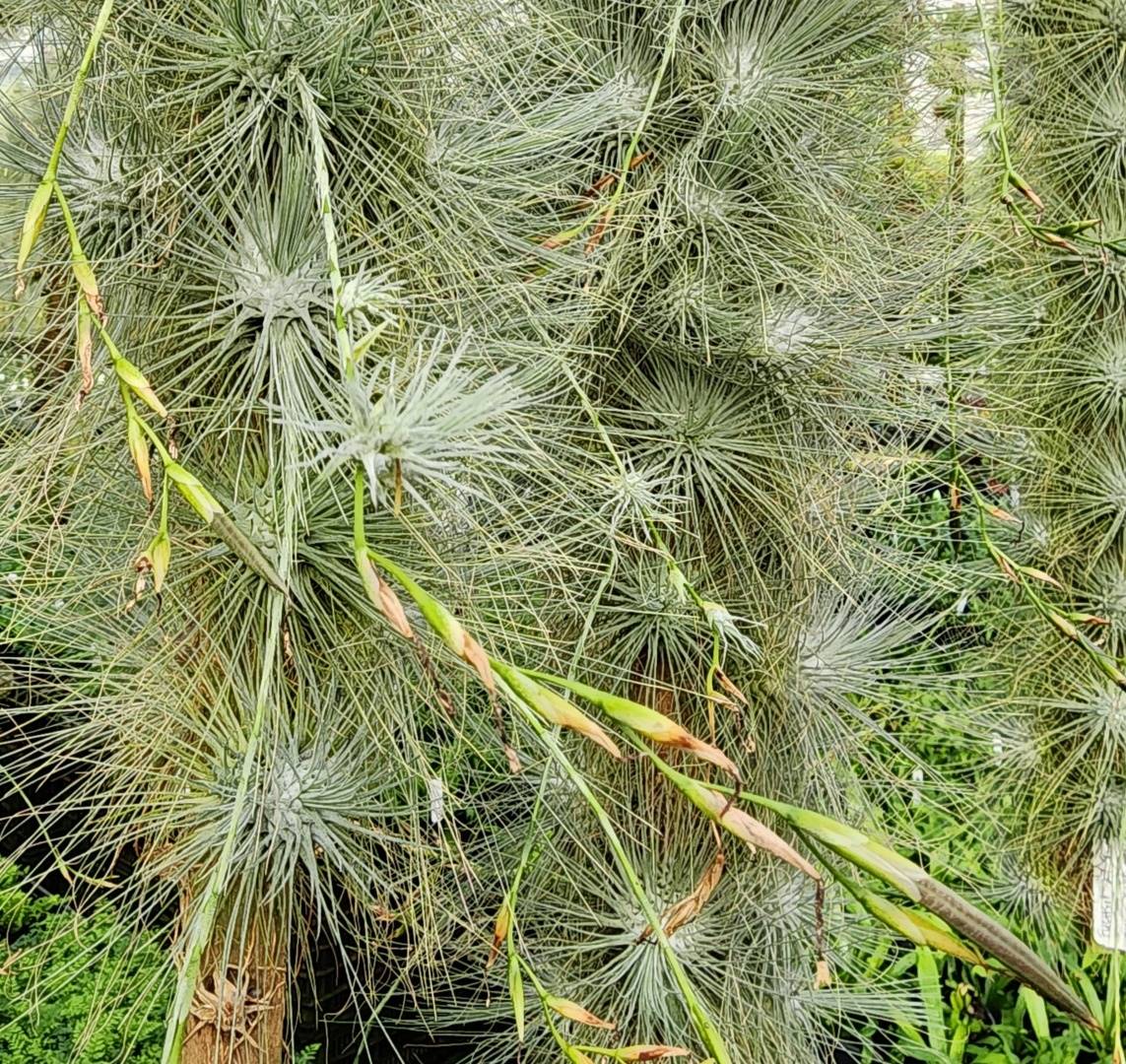
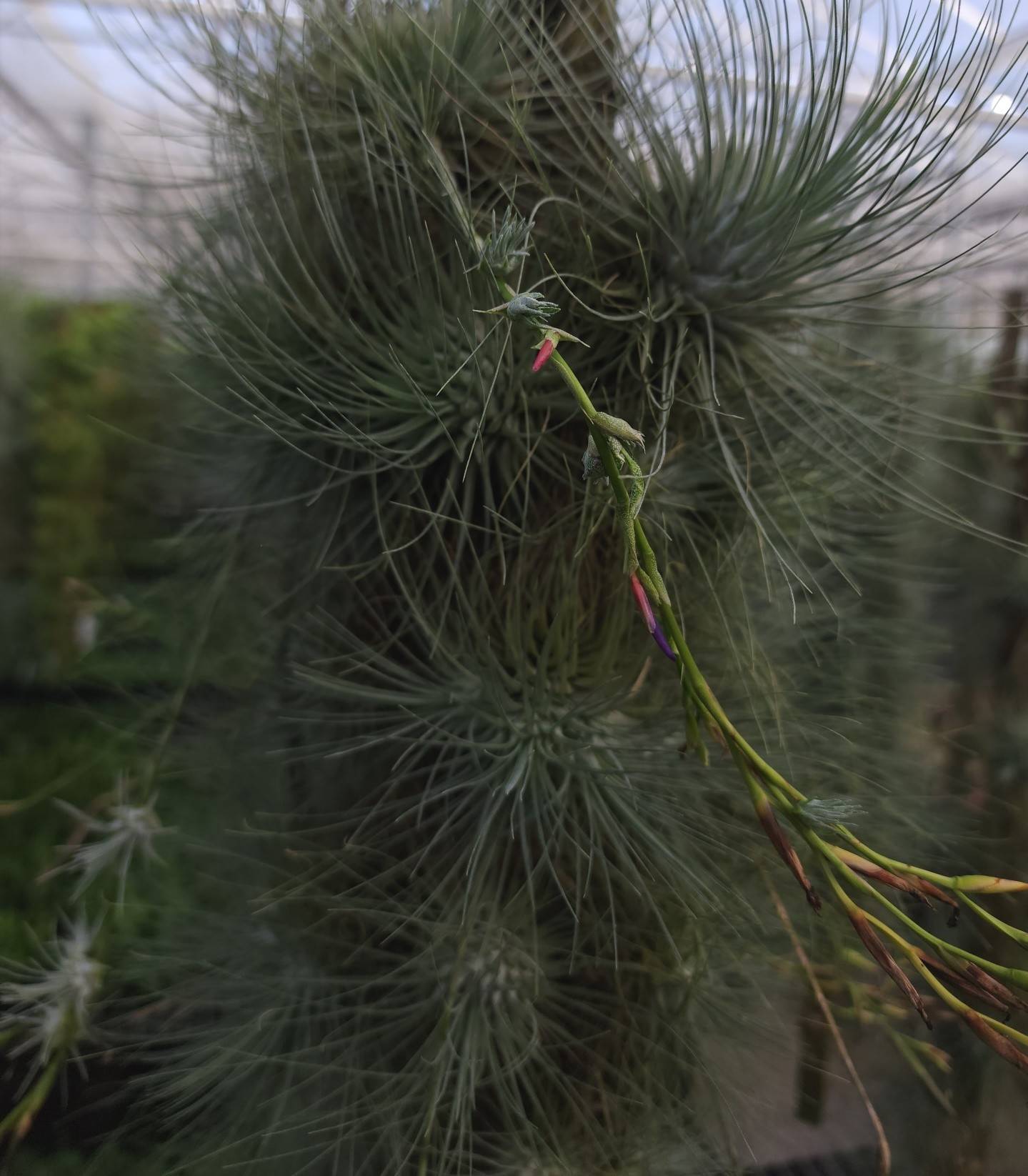
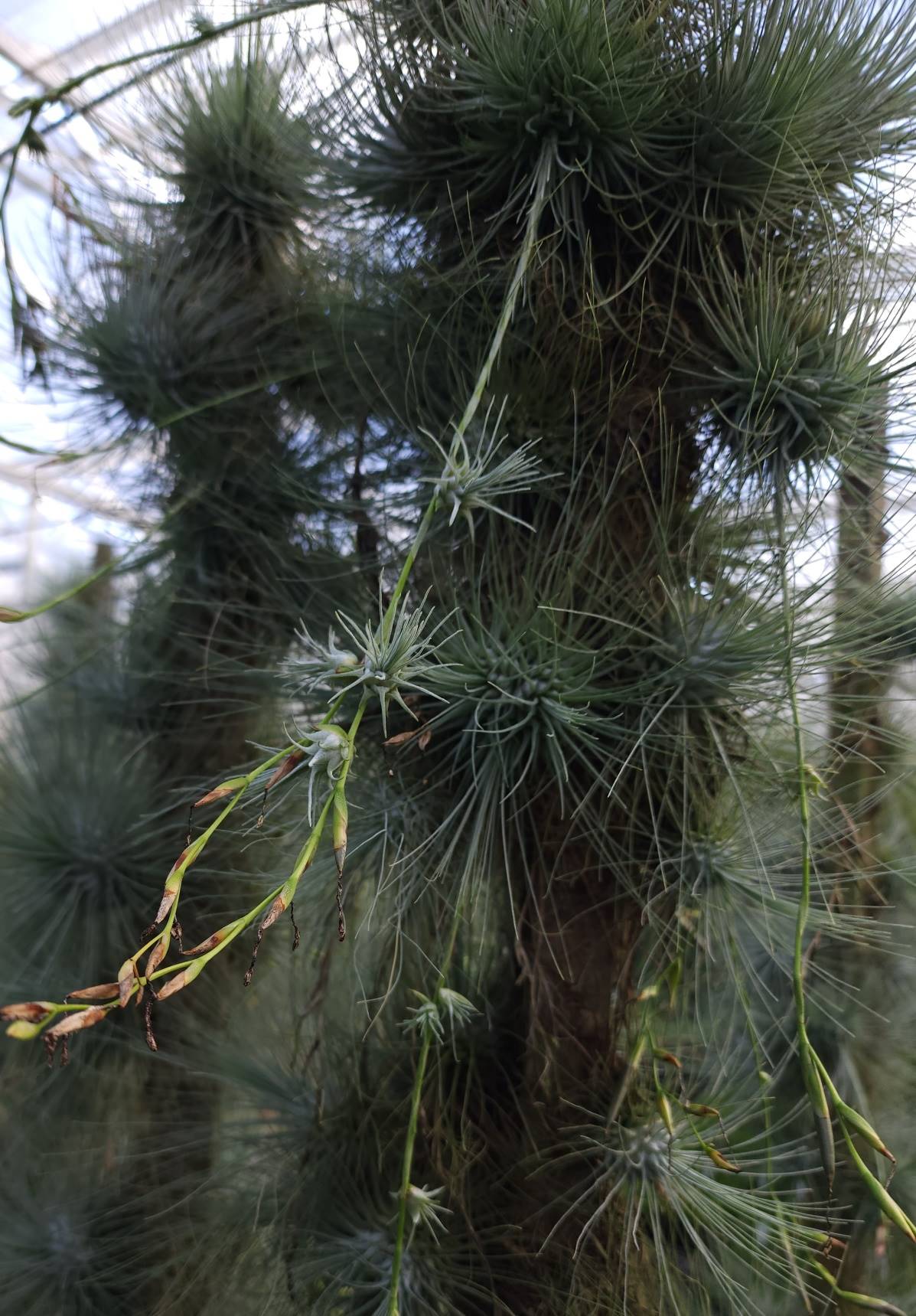
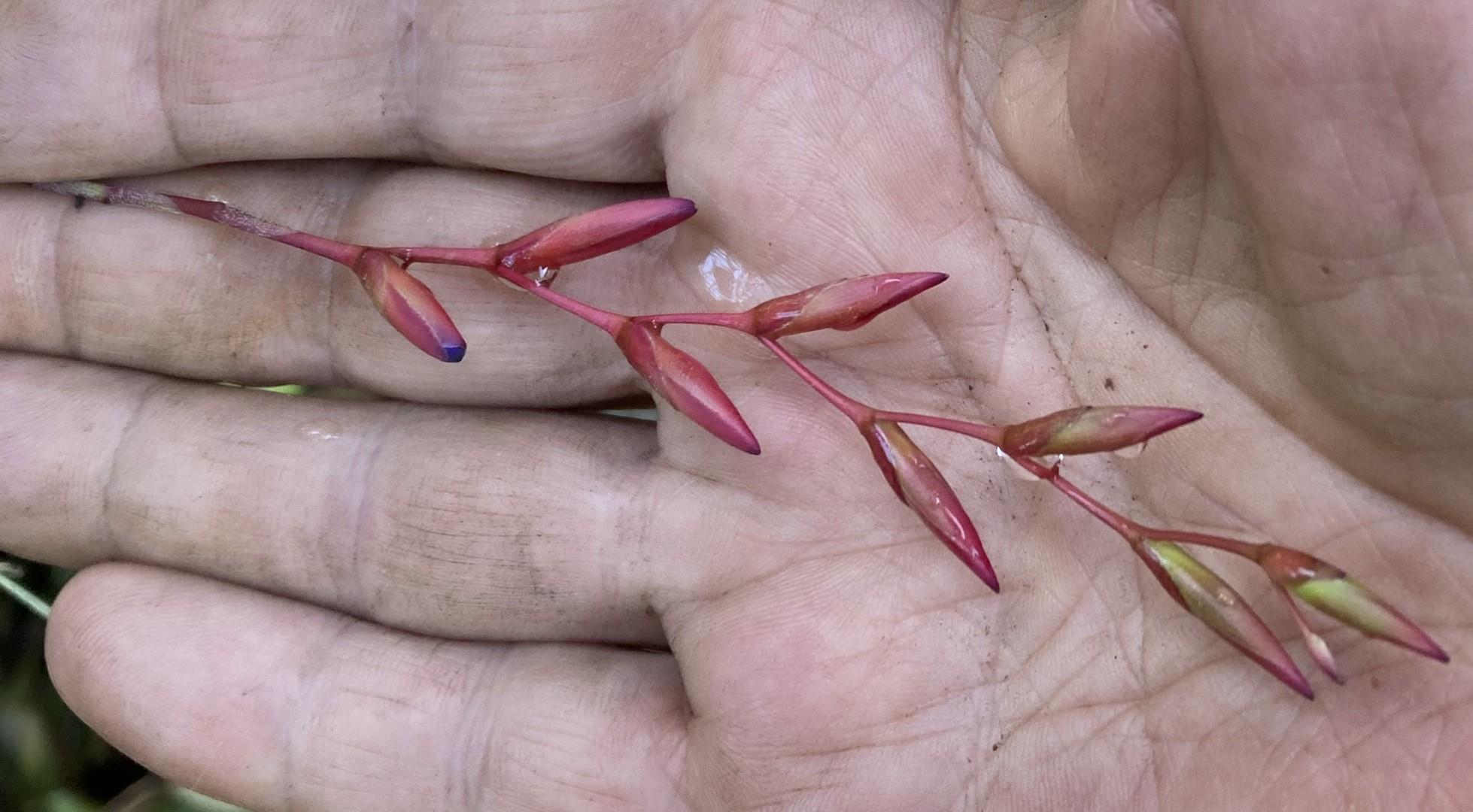
| Chris Larson 06/23 vivaporous (pups from flower bases) |
Ian Hook 11/23 vivaporous ex Chris Larson |
Chris Larson ... "Back in the good old importing days, the last of the T. fuchsii v. gracilis we imported (or maybe the second last) seem to be all this viviparous form. There were 1000s of course most came and went and we didn't notice. Over the years I kept noticing the residuals (mainly those damaged that we can't sell, so grow on) started having viviparous offsets.
How many of these got into Aussie collectors hands I don't know, as I haven't heard about them.
Just an oddity that is out there."
Graeme Barclay (NZ) ... "Nice one, quite common over here too."
Chris Larson ... "Interesting that it appeared across the ditch as well. We imported thousands upon thousands of this species between 1992 & 2014 while I've been working with the company, but (I think) we only imported one batch that were viviparous.
Of course, due to the volume of pups that each produces, the viviparous form will probably become, in time, the norm."
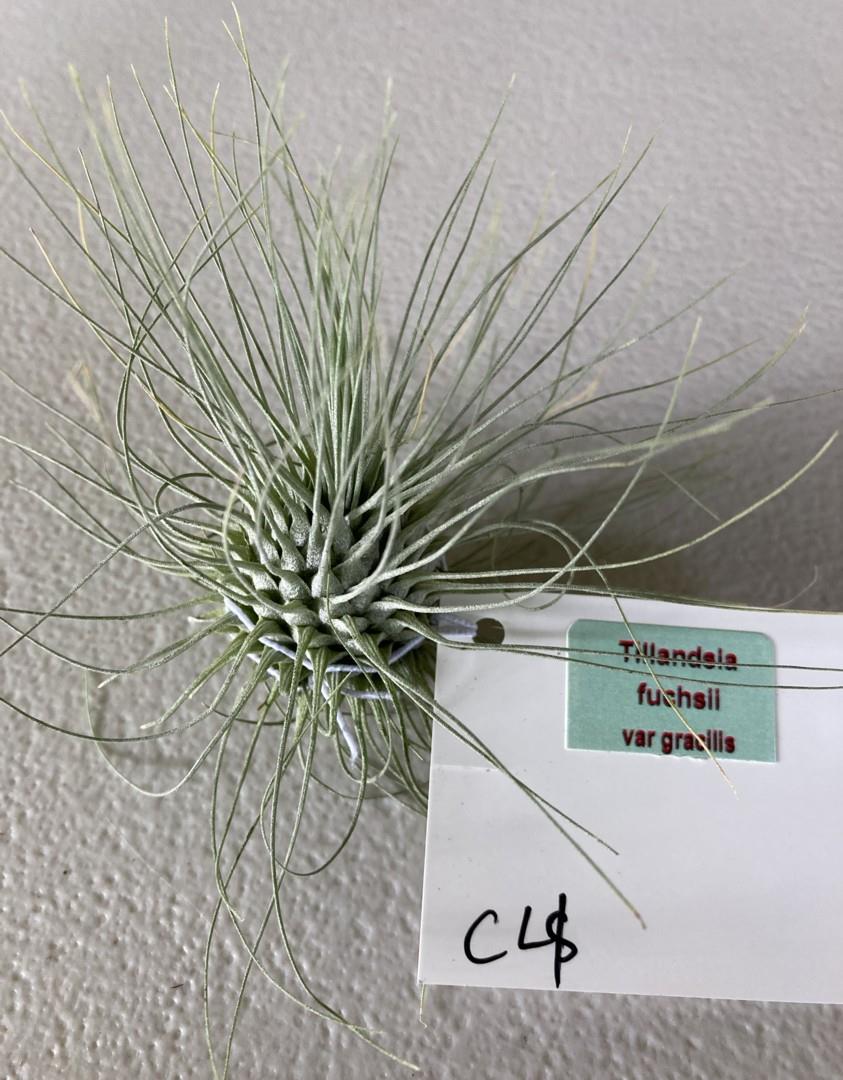
Tillandsia fuchsii W. Till sp. nova Die Bromelie 2/1990 p 30
See also J. Brom. Soc. 42: 99-102. 1992
Plant stemless.
Leaves globular rosette, (7-) 10 (-17) cm diam., 5-8 cm long.
Sheath 8 x 6 (12 x13!) mm, with almost parallel membranous edges, the lower 1/3rd thin and glabrous, the upper 2/3rds succulent, the same colour as the blade and densely appressed scaled.
Leaf blade ca. distinct from the sheath, tapering quickly from a short triangular base, linear, stiff, grey green, densely appressed scales, edged, topside not grooved, on the contrary somewhat succulent, above the base 1-1.3 (-4) mm wide, (2.3-) 4.56 (-9)cm long.
Scape 510 (-14 ) cm long, in a living state 1.41.5 (-3) mm diam., smooth, round stem, stiff erect or some what bent from the base, central, glabrous, dark wine red.
Scape internodes (5-) 6.510 (-12) mm long,
Scape bracts outside densely scaled, inside glabrous, the lower ones longer than the internodes, with up to 20 mm long, filiform blade, the upper ones as long or shorter than the internodes, tipped, the blade 710 mm long.
Inflorescence (3-) 7.59.5 (-15 )cm long, (3-) 5-10 (- 14) flowered.
Flowers scent-less, spreading from the rhachis, short and very robust stemmed, from the bottom to the stigma lobes up to 4 cm long, and ca. 4 mm diam.
Rhachis smooth, glabrous, half round, winged next to the flower, wine red, Internodes (8.5-) 9.510 (- 13) mm long, (the lower ones mostly longer)
Floral bracts wine red, ovate elliptic, rounded at the tip, smooth when alive, nerved when dry, inside and outside glabrous, (7.510.5) x (67.1) mm, clearly shorter than the sepals, broad membranous edges.
Sepals wine red, smooth when living, nerved when dry, inside glabrous, outside glabrous or the whole with a few scales, not keeled, 1.52 times as long as the rhachis internodes, narrow elliptic, broad rounded at the tip, anterior free, or connate to 0.8 mm, posterior 1-1.5 mm connate, broad membranous edged, (13.316) x (4.95.9) mm,.
Petals violet, at the base white, 2224.5 mm long, (4.5-) 6.17 mm wide, broad rounded at the tip, and somewhat hooded, forming an erect tube with a light tip, ca. 5mm from the base somewhat constricted, and clearly overlaps the edges, overlaps the stamens by 712 mm, and the stigma by 1015 mm.
Stamens in 2 unequal rows, the outer ca. 3mm longer than the inner,
Filament yellow green, moderately flat, the tip not or hardly broader,
Anther dorsifix, (in the middle), 2-2.4 (-4 ) x 11.3 mm, dark ochre to greenish brown.
Pollen egg to orange yellow.
Ovary egg shaped conical, pale green, ca. 4 x 2 mm.
Style thin yellow green, ca. 31 x 0.40.5 mm.
Stigma lobes with top of the style light green, clearly split into 3, papillose, at flowering with a somewhat colourless liquid.
Type locality Mexico, State of Oaxaca, between the towns of Oaxaca and Tehuantepec, ca. 1300 m. 1975 leg. S. Schatzl 75/ 23 (WU, Holotype): E. Zecher 1985 s.n. Mexico (WU, Paratype)
Table I. Comparison of the diagnostic characteristics
| Tillandsia argentea | Tillandsia fuchsii |
| short-caulescent | stemless |
| leaf sheaths not succulent, castaneous | leaf sheaths succulent, light green |
| leaf blades involute at upper surface | leaf blades not involute but angled and succulent at base |
| inflorescence 4 (-6) flowered | Inflorescence 510 (-14) flowered |
| floral bracts oblong-orbicular, 5.5-6.7 x 5.5-6.2 mm, laxly lepidote outside, with narrow hyaline margins | floral bracts ovate to oval, 7.510.5 x 67.1mm, outside normally glabrous, with broad hyaline margins |
| corolla zygomorphic | corolla actinomorphic |
| sepals broadly ovate-elliptic, 12-13.5 (-16) x 6-7.1 mm | sepals narrowly elliptic 13.3 16 x 4.9 5.9mm |
| petals crimson, narrowly lanceolate, not constricted above base and unlobed, not hood-shaped at apex, 27-27.5 x 5.1 mm | petals violet, lingulate, somewhat constricted above base and with lateral lobes, distinctly hood-shaped at apex, 22 24.5 x 7mm |
| filaments crimson like the petals | filaments chartreuse |
| style light crimson; stigma at same height as the anthers | style chartreuse; stigma mostly exceeding the longer stamens |
| distribution: Cuba, Jamaica | distribution: Mexico, Guatemala |
Tillandsia fuchsii forma gracilis W. TILL, forma nov. Die Bromelie 2/1990 p32
A forma typica laminis foliorum perangustis filiformibusque recedit. Chromosomarum numerus n=25 (M. Kiehn, adhuo non publicatus).
Typus: Mexico, Estdo. Chiapas, Dos Lagos, inter San Cristobal de las Casas et Comitan de Dominguez, leg. R. & K. Ehlers EM 82214 (= hort. bot. univ. Vindob. no. B 222/90), anno 1982 (WU, holotypus); Mexico, Estdo. Oaxaca, supra Putla in via ad urbem Tlaxiaco, 1200 m s.m., leg. R. & K. Ehlers s.n. anno 1978 (= hort. bot. univ. Vindob. no. B 221/90) (WU, paratypus); Mexico, Estdo. Chiapas, in jugo prope Motocintla in via ad urbem Tapachula, 1760 m s.m., leg. R. & K. Ehlers EM 891306 anno 1989 (= hort. bot. univ. Vindob. no. B 226/90) (WU, paratypus); Guatemala, prope Huahuatenango, leg. U. Feldhoff s.n. (= hort. bot. univ. Vindob. no. B 224/90) (WU, paratypus); sine loco et collectore, versimiliter Guatemala (WU, paratypus).
Differs from type in
1. Leaf blades narrow filiform.
Tillandsia fuchsii var. stephani W. TILL var. nov. Die Bromelie 2/ 1990 p32
A varietate typica inflorescentia olivacea nec rubra, internodiis rhachidis longioribus, bracteis florigeris et sepalis acutis et stigmatibus violaceis antheris aequilongibus recedit.
Typus: S. Schatzl 77/60, Mexico, Estdo. Jalisco, km 20 in via a Puerto Va!larta ad Manzanillo, anno 1977. (WU, Holotypus); ibidem, km 35, S. Schatzl 77/57 (WU, Para-typus).
Differs from type in
1. Inflorescence greenish brown not red
2. Rhachis internodes longer
3. Floral bracts acute
4. Sepals acute
5. Stigma violet and as long as the anther
From Walter Till in J. Brom. Soc. (42: 99-102. 1992)
One of the most beautiful, small tillandsias, much desired by growers, is generally known as Tillandsia argentea. The plants have a bulbous habit because of the succulent leaf bases. The leaves are slender, more or less cylindrical, and tapering to a fine, sharp point (subulate). They are densely covered with a grey, frostlike bloom. The lax, simple inflorescences are coral-colored and bear 5-10 flowers with radially symmetrical violet corollas. They are found on the western side of the Sierra Madre in Mexico and southward as far as Guatemala.
If one reads the different descriptions, red and violet can be found as the color of the petals, but nobody investigated this discrepancy. In addition, the other characters derive from two different taxa and, as a result, all descriptions are a mixture.
Grisebach founded his Tillandsia argentea on fruiting material from southeastern Cuba collected by C. Wright in 1859. The type specimen is deposited in the herbarium of the University of Gottingen, Germany. An additional specimen is kept in the herbarium of the Museum of Natural History in Vienna, Austria, and probably also represents a type. Both specimens strongly resemble the habit of the plants collected in Mexico and Guatemala but they do not form bulbs since their leaf sheaths are not succulent. Plants of this kind are found only in Cuba and Jamaica.
In the last few years, living material has been imported by various Austrian and Czechoslovakian collectors from Cuba when that country increased its efforts to attract tourists. The vegetative plants attracted my attention and when they flowered in the greenhouse of the University of Vienna garden it was clear that they were different from the Mexican and Guatemalan plants. A comparison with the type specimen from Gottingen revealed that the living samples were completely identical with Wright's collection of nearly 130 years earlier.
As there are no synonyms under Tillandsia argentea, the mainland plants had to be described as new. I named them in honor of Franz Fuchs, the chief gardener of the Botanical Garden at Linz, Austria, for his merits in cultivating tillandsias and other bromeliads.
Since the plant in question is well known by most growers, it is not necessary to give an extensive description here, but it is introduced by the accompanying illustrations.
Typical plants (fig. 1) are found in the southeast of the state of Oaxaca, Mexico, between the cities of Oaxaca and Tehuantepec at an elevation of about 1300 meters above sea level. They represent the coarse-leafed form. Plants from the Mexican states of Michocan and Guerrero obviously belong also to the typical form.
In the state of Chiapas in southern Mexico and in Guatemala, Tillandsia fuchsii tends to have thinner and more slender leaves. I have described it as forma gracilis.
More striking and interesting is a population from the western part of the state of Jalisco, Mexico, which I have named in honor of the collector, Stefan Schatzl, senior gardener of the Botanical Garden at Linz, as Tillandsia fuchsii variety stephani (fig. 3). It differs from the typical variety by its wine-red to maroon inflorescences, the longer internodes of the rachis, the acute floral bracts and sepals, and the violet stigmas. That variety settles at the northwestern end of the distribution of T. fuchsii.
It should be noted that Tillandsia fuchsii is endangered since it is over-collected for commercial purposes. Thousands of plants are ruined each year in florist shops where they are stuck on pieces of wood or stone. They are completely unadaptable to the average apartment climate. Trade in this species should be limited exclusively to material grown from seed by horticulturists.
Key to varieties of T. fuchsii
1. Inflorescence red => 2
1. Inflorescence greenish brown => var stephanii
2. Leafblades angled and succulent at base => var fuchsii
2. Leafblades narrow filiform => forma gracilis
Updated 21/05/25


















